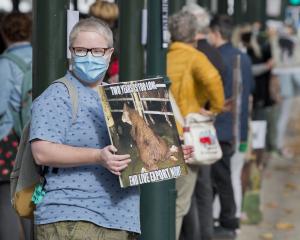The word Toitu has become shorthand for the Settlers Museum since the name for the stream that ran through early Dunedin was added to the facility in 2012. But just where is that historic water course now? David Loughrey set out on an expedition to follow the stream's path from the soft, dappled light of Belleknowes to the metallic grind of the industrial sector.
In a thick cut of bush near Alison Cres, in Belleknowes, the Toitu Stream makes a quiet start on its journey from the clogged chaos of untrammelled nature to the paved climes of commerce and industry.
Down a set of steps near the corner of Harcourt St, in one of those moist green thickets that hide in the Dunedin Town Belt, Toitu's beginning is more of an area of slightly damp leaf-strewn mud - an extended wet patch - than a stream.
Its eventual emergence in full flow, though, is already building, as runoff from properties on the hill gurgles in nearby drains.
What there is of the stream goes underground by Alison Cres, but roughly cut tracks under a mattress of autumn leaves follow a small, dry, but deep, gorge through the bush.
A tangle of gnarled tree roots that grip the soil like a dying man's hand - and a home for discarded tyres - it takes the explorer ever downward to Queens Dr, where it suddenly stops: the only monument to the stream a drain cover set in concrete.
A trot of a few hundred metres southwest takes us to a minor tributary that runs down to Maori Rd, another mostly dry but deeply attractive gorge soaked in birdsong and the sweet smell of nature.
It is only once Jubilee Park is reached the tributaries begin to develop a gentle, regular flow.
They spill out from two separate concrete outlets, burble through steel grates, and wind through the park to meet at a confluence marked by fantails that so far have ducked and bobbed in the periphery like half-forgotten dreams, but now brazenly land within reach and cock their little heads inquisitively.
Perhaps they are watching for the human response to the shopping trolley jammed right in the centre of that otherwise lovely confluence, with an ironic advertisement for Panadol bolted to its front.
Skirting the edge of Jubilee Park, on gentle paved tracks, past disturbing looking fungi, we pass the last we will see of our little stream in some sort of natural environment, as it dips into the underworld.
Here, our path stumbles from the bush at Canongate and trips down Maclaggan St, as the now underground Toitu runs through about 80m of pre-1870s pipe for which plans do not exist.
That pipe runs next to businesses dedicated to doors, paving, cupcakes and air conditioning, before passing something of a crossroad at Broadway.
For it is here, flowing down the Broadway gutter, what was probably once a gentle tributary to Toitu stubbornly makes its presence felt.
Into a building on the street, a spring forces a flow of water - perhaps the remnants of a side-stream seen on historic maps - into a lift shaft.
That water is pumped on to the street, and flows sometimes gently, sometimes in a small flood, past the Crown Hotel.
Meanwhile, below street level, Toitu again emerges into an environment of some beauty and awe.
Through grand brick tunnels it bubbles, merging with the stormwater flow from Rattray St, before flowing confidently along its arched mausoleum, across Princes St.
Past a city brothel it burbles, under the rumbling traffic of Queens Gardens, gently kissing the sharp edge of its museum namesake, flowing proudly under railway lines, before turning into the final straight: Mason St.
Here it passes unnoticed beneath the hard gazes of watchful men in overalls, who have stopped for a quiet moment after hauling unnamed steel creations across dirty warehouses.
It babbles under businesses devoted to o-rings and pneumatic seals, past tuck shops with ham and egg sandwiches, near outlets selling spare parts for machinery you've never seen before.
Finally, under Fryatt St, Toitu approaches its end at the harbour, though a peek under the wharf to see the final destination of the stream is blocked by barbed wire on the wharf, and signs warning of a Licensed Customs Controlled Area.
From the suburbs to the sea, Toitu continues its ancient path, from Dunedin's bushy past to its industrial present, buried in part, but babbling unbowed.












